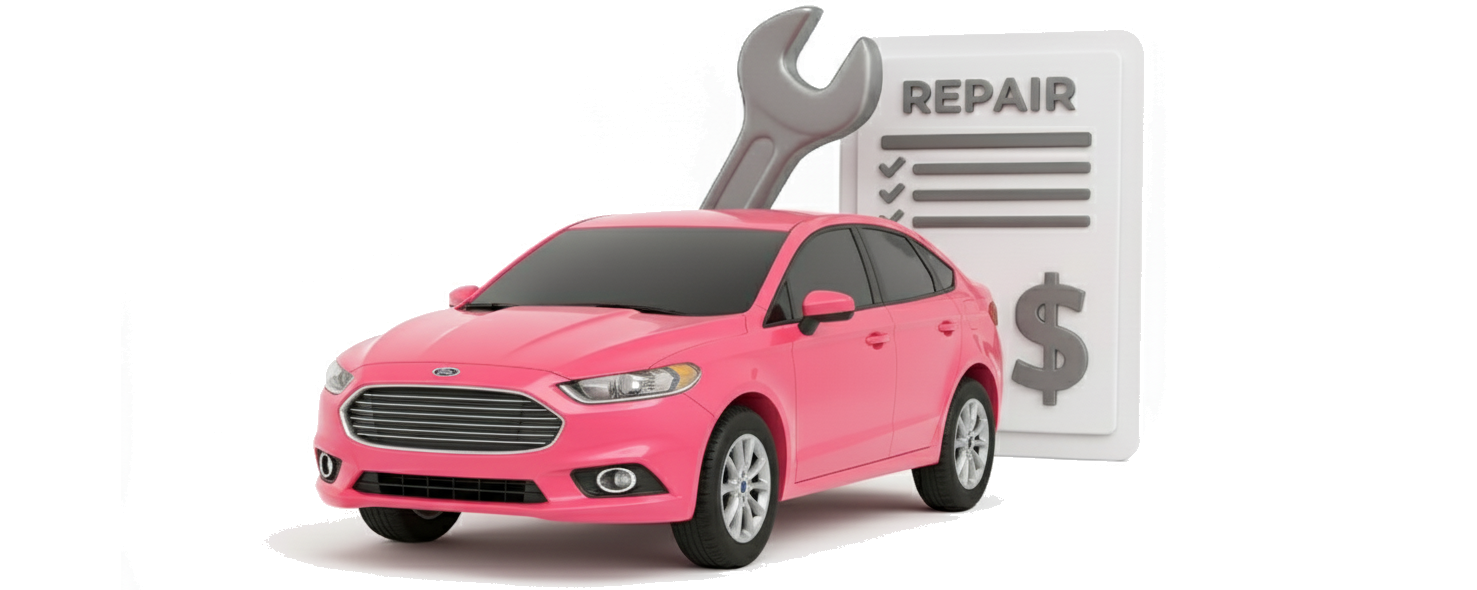If your rotors also need to be replaced, that replacement cost brings the total to $322–$586 per axle (and up to $900+ on some luxury or performance cars).
A full brake job for all four wheels typically runs $296–$429 for pads only, or $616–$1,092 with rotors. That estimate includes parts, labor and typical shop fees. Front brake pads usually cost slightly more than rear pads, and prices vary by vehicle class, pad material and local labor rates.
Real customers Jerry helped
What you’ll pay for a brake pad replacement can vary with your vehicle, location, and parts selection. Jerry lets you instantly see what other drivers are paying right now. Below are a few examples of customers we’ve helped find the most competitive prices on their brake pad repairs:
Estimates are modeled based on real vehicle and location data; names have been changed. Actual prices will vary by shop, parts, and vehicle condition.
Cost breakdown: Why the price varies
Jerry helps customers track down great repair prices every day, and we’ve learned there are a few key reasons those prices can differ:
Vehicle type and trim:
Economy sedans can be as low as $150–$250 per axle for pads, while luxury, EV or high-performance models can be 25–100% higher. Bigger, heavier brakes require larger, pricier pads and more labor time.
Pad material:
Organic pads are budget-friendly while semi-metallic is a strong all-around choice—and ceramic pads are the quietest and cleanest but add about 10–30% to parts cost (roughly +$40–$120 per axle) compared with semi-metallic. Premium brands and low-dust formulas cost more.
Front vs. rear:
Front pads do more stopping work and typically cost 10–20% more than rear pads due to larger pad area and higher heat loads.
Rotors:
Adding rotors usually increases the job by $150–$400 per axle—the brake rotor replacement cost component. Many modern rotors are designed to be replaced rather than resurfaced.
Labor rates:
Brake pad replacement generally takes 0.8–1.5 hours per axle. At $100–$200/hr, labor can be $80–$300 per axle—30–50% of your brake service cost depending on shop and region.
Hardware and sensors:
New abutment clips/shims and electronic wear sensors (common on European cars) add $10–$80 per axle but help prevent noise and uneven wear.
Shop type and location:
Dealerships often run 15–40% higher than independent shops. Urban areas and coastal regions tend to have higher labor rates.
Condition-related extras:
Seized slide pins, stuck calipers or excessive rust may add $50–$300 in parts/labor. If a caliper is dragging or leaking, replacement can push the repair into the $300–$600+ per corner range.
Pro tip: If your quote seems high, check whether it includes pad grade, rotors, hardware, sensors, and any extra labor for corrosion or caliper issues—and ask for rotor thickness vs. minimum and runout measurements.
What is a brake pad?
A brake pad is the part your brakes squeeze to slow the car down. It sits in the brake caliper and presses against the metal rotor when you hit the pedal, creating friction to stop the car.
Brake pads come in a few common types: organic (soft, quiet, but wear faster), ceramic (very quiet, low dust, usually more expensive), and semi-metallic (great stopping power, good for heat, but can be noisier and harder on rotors).
All pads wear out over time. If you hear squealing or grinding, or the car takes longer to stop, it’s time to have them checked and likely replaced.
When new pads go in, the part that squeezes the pads (inside the brake caliper) has to be pushed backward to make room for the thicker pads. That creates a little extra space, so the first few pushes of the brake pedal are just taking up that gap instead of giving you full braking. Pumping the pedal until it feels firm moves everything back into its normal working position.
Back when I was in technical school, another student skipped this step. He finished the brake job, started the car, put it in reverse, and expected it to stop when he hit the brakes—but the pedal went down with almost no resistance and the car rolled right into a wall. After seeing that, I’ve never forgotten to pump the pedal until it feels firm before moving the car.

Signs that your brake pads need to be replaced
It pays to recognize the signs of brake pad trouble. From working with real drivers on their car issues, Jerry has found these are the key things to look out for:
- Squealing at low speeds: Many pads have a wear indicator that chirps when the pad is thin—consider it your “last call” to replace.
- Grinding or growling: That’s metal-on-metal. Stop driving and replace pads and likely rotors immediately to prevent further damage.
- Longer stops or soft pedal feel: Pad material may be worn, overheated or contaminated.
- Vibration or pulsing when braking: Often a rotor issue (thickness variation or warping), but uneven pad deposits can also do this.
- Dashboard brake wear warning: Common on vehicles with electronic wear sensors.
- Visual check: If pad thickness is under ~3 mm, it’s time.
Your action plan: How to save money
You can keep braking costs in check without compromising safety by following a simple strategy:
Confirm the diagnosis:
Ask the shop to measure pad thickness and rotor thickness/runout. Under ~3 mm of pad material is due to be replaced now, while rotors at/below the stamped minimum should be replaced. Runout above ~0.004 in or noticeable thickness variation can cause pulsation. Customers use the Jerry app to get a confident diagnosis before taking their car to the shop.
Choose the right pads:
Semi-metallic pads offer strong bite and heat resistance for standard driving, towing or mountain use. Ceramic pads cost more but reduce dust and noise—great for daily commuters. Reputable OE-equivalent brands include Akebono, Wagner, TRW, Bosch, Raybestos, Brembo and Textar (European).
Get itemized quotes:
Request part numbers/brands, an out-the-door price and whether hardware, sensors and rotor machining included.
Replace rotors when it makes sense:
If rotors are thin, warped or heavily grooved, changing pads alone can cause noise or vibration. In salt states, choose coated rotors to resist rust. The Jerry app helps customers get quotes from multiple services at once.
Avoid the false economy:
Ultra-cheap pads can be noisy, dusty and wear out fast. A mid-grade or OE-equivalent pad is often the best value.
Bed the brakes properly:
After new brake pads are installed, make 8–10 medium stops from 35–45 mph to near 10 mph with cool-down driving between. You should also avoid braking hard or quickly at first to reduce squeal and extend rotor life.
Ready to compare options and book? Download the Jerry app to check instant brake pad replacement cost quotes for your exact car and ZIP code, compare independent shops vs. dealerships near you and schedule service.
DIY vs. Pro: Can I do this myself?
If you’re on the fence about fixing your brake pad yourself or going to a mechanic, Jerry can give you clear pricing on both parts and labor. Here are the key things to weigh before choosing the DIY route.
| Factor | DIY | Pro |
| Skill/tools | Jack stands, torque wrench, piston tool; EPB service mode if equipped | Certified techs with specialty tools/scan tools |
| Time | 1–3 hours per axle for a first-timer | 45–90 minutes per axle |
| Safety risk | High if done incorrectly | Low; work is tested and warrantied |
| Cost | Save labor ($80–$300 per axle) | Pay labor rates for quality control |
| Complexity | EPB resets/sensors; open bleeder when pushing pistons back | Scan tools handle EPB resets and diagnostics |
| Quality/noise | Depends on prep: clean hubs, replace clips and silicone/ceramic lube on pins | Consistent results and fewer comebacks |
| Warranty | Parts only (if any) | Parts and labor coverage common |
Safety note: After brake pads are replaced, the brake pedal must be depressed and released several times before driving. The brake pedal will feel soft, then firm up and feel normal again. If this is not done when the vehicle is first driven, the brakes may not work and the car will be unable to stop.
Related repairs
When you need new brake pads, you might want to look into other related services too—bundling them can lower your overall cost. Jerry makes it easy to compare reliable prices for several repairs at once.
- Brake rotors (rotor replacement cost): $200–$400 per axle installed for standard vehicles; more for performance or oversized rotors. In rust-prone regions, select coated rotors.
- Calipers: $250–$600 installed per caliper if seized, leaking or dragging.
- Brake hardware kit: $20–$80 installed per axle for new clips/shims that prevent uneven wear and noise.
- Electronic wear sensors: $25–$80 installed per axle on vehicles that use them.
- Brake fluid flush: $90–$160. Fresh fluid protects ABS components and maintains a firm pedal.
- Parking brake service/adjustment: $60–$150 depending on design.
What our customers are asking
-
How long do brake pads last?
-
Can I replace pads without replacing rotors?
-
Do I have to replace pads on both wheels of an axle?
-
How long does brake service take?
-
Are ceramic pads worth it?
-
Is bedding-in really necessary?

Steve Kaleff began working on cars at the very young age of nine years old, when his dad actually let him make fixes on the family car. Fast forward to the beginning of a professional career working at independent repair shops and then transitioning to new car dealerships. His experience was with Mercedes-Benz, where Steve was a technician for ten years, four of those years solving problems that no one could or wanted to fix. He moved up to shop foreman and then service manager for 15 years. There have been tremendous changes in automotive technology since Steve started his professional career, so here’s looking forward to an electric future!

Nick Wilson is an editor, writer, and instructor across various subjects. His past experience includes writing and editorial projects in technical, popular, and academic settings, and he has taught humanities courses to countless students in the college classroom. In his free time, he pursues academic research, works on his own writing projects, and enjoys the ordered chaos of life with his wife and kids.









